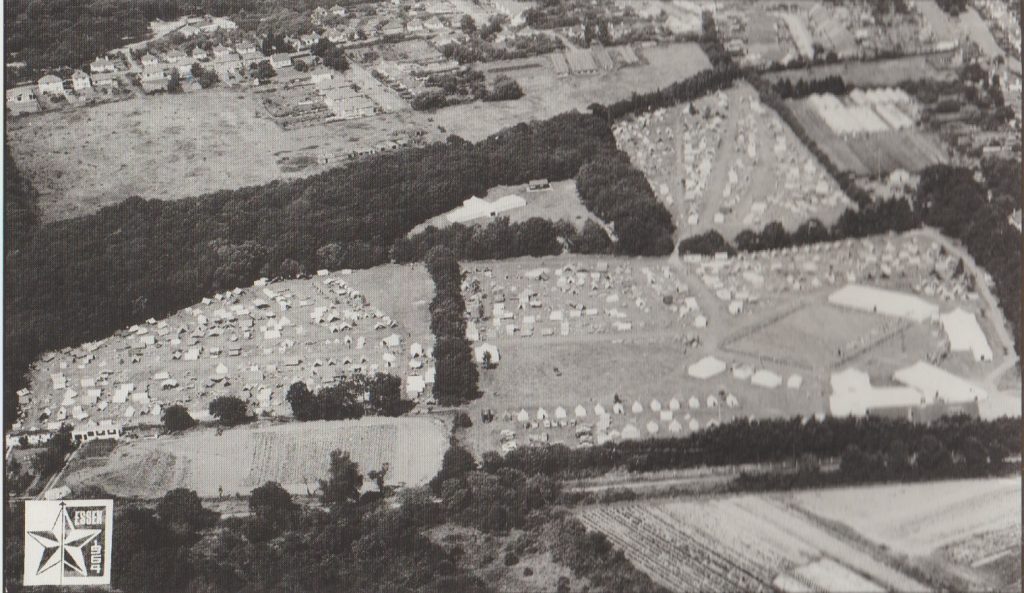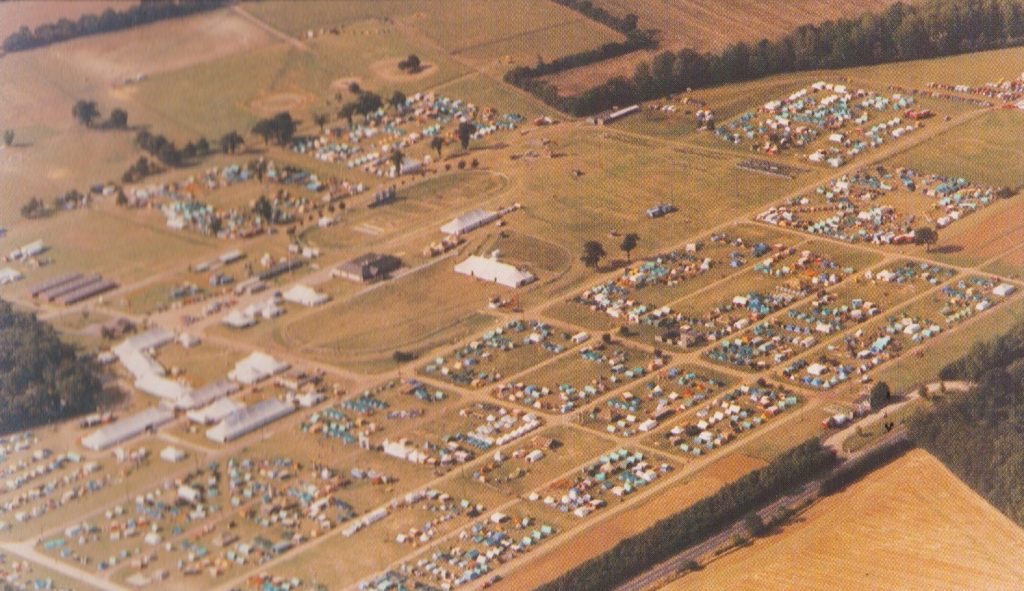ESSEX INTERNATIONAL SCOUT & GUIDE JAMBOREES
Brief History prepared by Malcolm Treacher (Archivist)
Back in 1927 Essex held a large Rally of Scouts at Priory Park Southend which was visited by the Founder, Robert Baden-Powell, and it is recorded that he received a rousing welcome by the Scouts.
In 1947, at a long weekend of Whitsun the first Essex Scout Jamboree was held at Danbury Park, Chelmsford, this time attended by the then Chief Scout of the Commonwealth Lord Rowallan, greeted by some 2000 Scouts from Essex and other UK Counties. Because of its success it was decided to widen the event and two years later in 1949 a full week long Jamboree was held at Belchamps Campsite, Hockley. This time it was open to Scouts around the world, again with a visit by the Chief Scout.

The next was in 1952, moved a year to avoid clashing with World Jamborees, from then Essex Jamborees have continued every four years since, held at Belchamps until 1980, then because of need to expand in size, and Belchamps being limited to 2,500 it was decided to move and in 1984 the event was held at the Essex County Show Ground at Great Leighs (now a Race Course), with numbers up to 3,500. This was to see girls joining in having linked with the Girl Guides. Also with the move a new style of event took shape, previously every camp drew daily rations from a central depot having the same menu, now we had a full scale outside supermarket set up and camps bought by choice as required.
The Jamborees still had visits by Chief Scouts, having included Sir Charles Maclean, Sir William Gladstone, Major Gen. Michael Walsh, and Garth Morrison. In 1976 the Founders grandson Lord Robert Crause Baden-Powell, also made a visit.
Numbers continued to grow and in 1996 it was moving again, this time to Kirby-le-Soken with some 5000 in camp. The Chief Scout was George Purdy. It should also be mentioned that every Jamboree received visits from Essex Mayors and Council Chairmen and in some cases other Chief Scouts and Chief Guides. The next location move came in 2012 back to the Chelmsford area on a site at Boyton Cross, Roxwell.

Out of interest the Essex Jamborees have had contingents from over 70 different countries from around the world and the attending numbers have increased up to 10,000 plus.
Our Jamborees have all been organized by voluntary teams of leaders and heads of departments, including the Catering, Markets, Fast Foods, Medical, Religions, and later a Leaders Bar. The Programme Team has changed in its style over the years and whilst the early camps enjoyed evening campfires, the later events have seen the Discos and Partying. A regular activity were daily coach trip outings to places of interest.
It must be recorded that the Jamborees have depended strongly on the Service Teams (MASH) for all the background jobs to keep the event in full swing daily.
Every Jamboree has had its special Jamboree Badge and a few people still have a full set of these. Likewise a small booklet or programme has been produced for attendees’ information; the County Archives hold a full set of these for reference.
The structure of the Jamboree has kept to a similar pattern over the years, with a HQ base for Administration etc., a Market area for shops and activities marquees, a Faiths Base, and at one time chapels for the various religions. The camps themselves are set out in sub-Camps with their own HQ teams, these have usually had special names to identify them, and these have varied from Colour Codes, Essex Rivers, past World Jamboree names, Capital cities, World features, i.e. Grand Canyon, Everest etc. National Parks, Essex Roman Place names, Constellation signs, even Greek Gods. The central Arena saw daily events including sports competitions along with football, ending the week with a final of Essex v the World. The Entertainment Marquee saw evening talent shows with the overseas contingents putting on traditional dances and songs. The camp daily newspaper 'Jamboreeposte' gave details of happenings and a who's who of visitors; it also listed the bookings for coach outings and intended locations such as Canterbury, London and Colchester Zoo. One special event held in the early years was a boat trip up the Thames on the 'Daffodil' cruise ship.
The trip on The Daffodil involved firstly marching some 1,500 Scouts from site to Hockley railway station and on to a special train to Southend, a march through the town, with police supervision, to the pier, then down to the end of the pier on foot to embark on to the ship. The scouts disembarked at the Tower of London for a look round and then back on the ship for the return. This was quite an exercise as one might imagine with the marshals having to control the mass of Scouts of mixed nationalities, fortunately there were a couple of interpreters on the team. The financial costs involved in this trip saw the end of this event after 1968.
From the early years the practice of Home Hospitality by Essex families for all the overseas contingents operated, but as numbers increased this was slimmed down but some still continued to offer home links for their regular visitors.
During the 1980's saw the introduction of some brilliant firework displays on the last evening. In 1996 the Jamboree included the Global Village with overseas teams setting up displays with cultural activities.
The Jamboree for 2016 was also at Boyton Cross with some 10,000 campers. With the size and shape of the main field at Boyton Cross, the layout of the sub-Camps is in a large horseshoe shape.
Fresh organising teams over the years have each experimented with new ideas and so it should be, but it is important we learn from events of the past to make sure every four years Essex continues to offer the world a great Jamboree experience.
Only ____ days, __ hours, and __ minutes to go until EIJ2028!